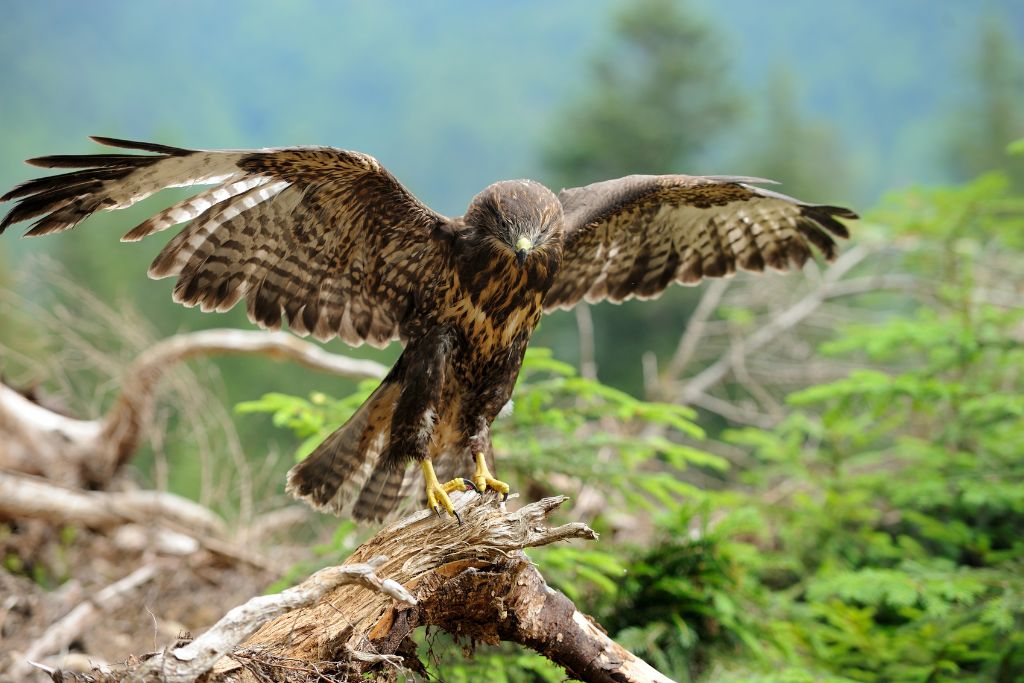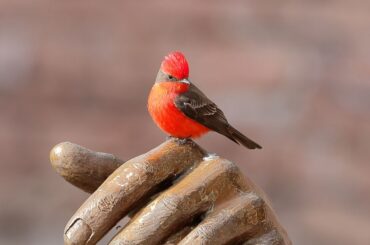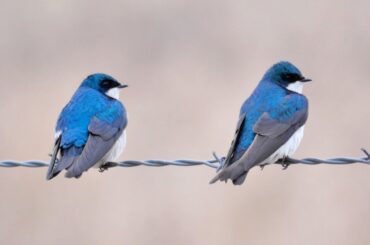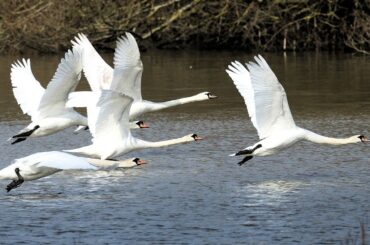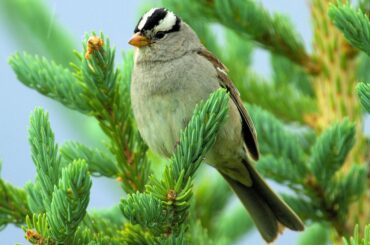Have you ever marveled at the magnificent sight of hawks soaring through the skies of Michigan? Bird watchers and nature lovers marvel at these graceful, powerful, and skilled hunters. Hawk species have adapted to Michigan’s diverse environments and rich food supplies.
These fantastic creatures have exceptional eyesight and can identify prey from far away. They can spot even the smallest rodent running through dense grass or a fish swimming beneath a lake. Their strong eyes can see ultraviolet light, which humans cannot, giving them an advantage when hunting.
Did you know that hawks exhibit a fascinating behavior known as “mantling?” Spreading its wings and crouching low, a hawk creates a “mantle” around its prey to keep it safe after capture. By mantling their prey, hawks can enjoy their meal undisturbed.
What do Hawks look like in Michigan?
Michigan hawks range in size, with the largest reaching 25 inches long and 4 feet in wingspan. Smaller hawks can also be found, with some species reaching a more modest length of around 15 inches.
Most species have brown and white feathers for camouflage in woodlands and fields. Michigan hawk species often have a white chest contrasting with the rest of their plumage. Observing one of these birds soaring gracefully through the air is a sight to behold.
1. Red-Tailed Hawk
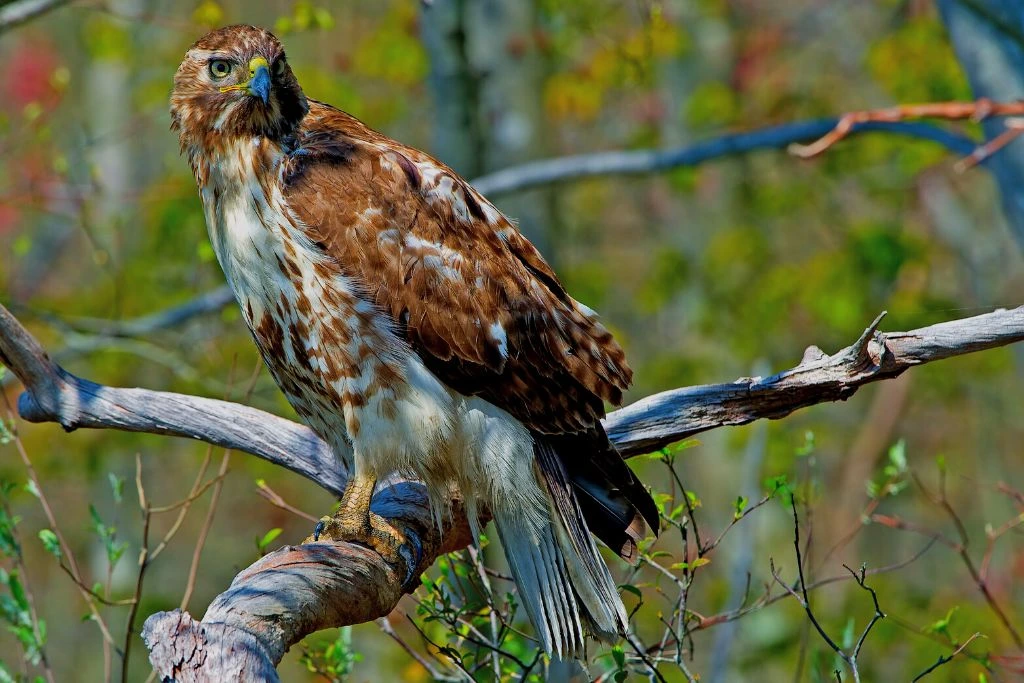
- Kingdom: Animalia
- Phylum: Chordata
- Class: Aves
- Order: Accipitriformes
- Genus: Buteo
- Species: B. jamaicensis
The red-tailed hawk (Buteo jamaicensis) is a large bird with a 4 feet wingspan and a 2 feet body. The majority of them are primarily dark brown on the back and wings, with lighter, striped coloring on the chest and belly.
Named for its bright red tail, which gets more prominent as the bird ages, this species of hawk is easily recognizable. Juvenile red-tailed hawks have a brown tail that develops the characteristic red hue as they grow older.
Some wild populations of these birds have been seen to have adults 20 or older. They are also known for their distinct vocalizations. Their call, a high-pitched scream often associated with eagles in movies, is frequently used to represent various raptors on screen.
Common in both rural and urban regions, red-tailed hawks can be seen all over the state of Michigan. They frequently hunt from great heights, which explains why you could spot them perched atop trees or telephone poles. Nature reserves, state parks, and open fields are good places to observe these beautiful birds.
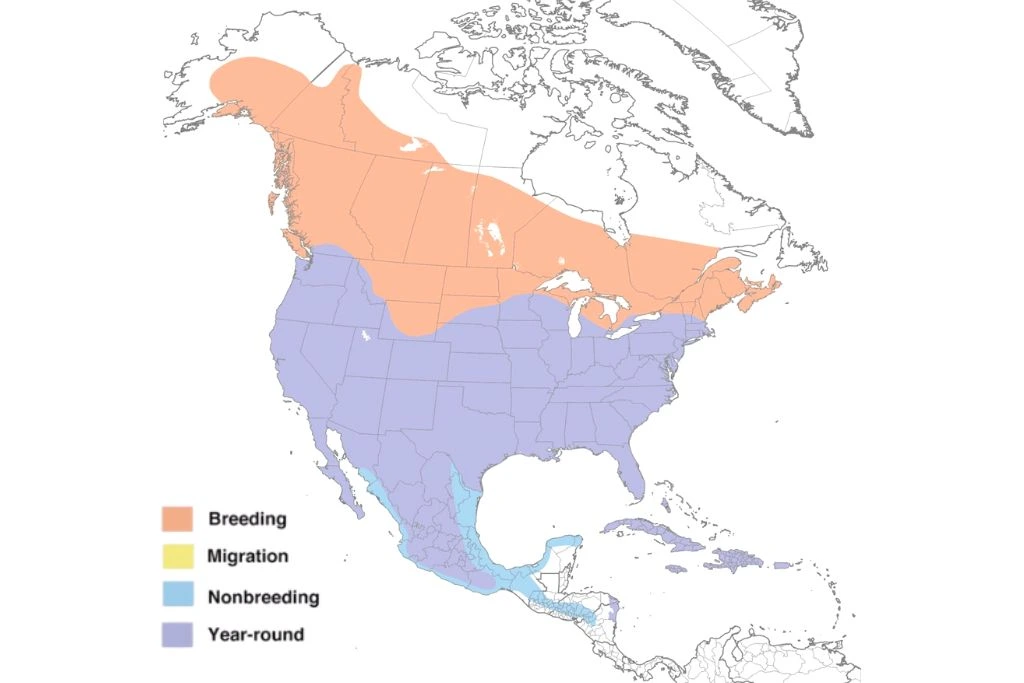
2. Cooper’s Hawk
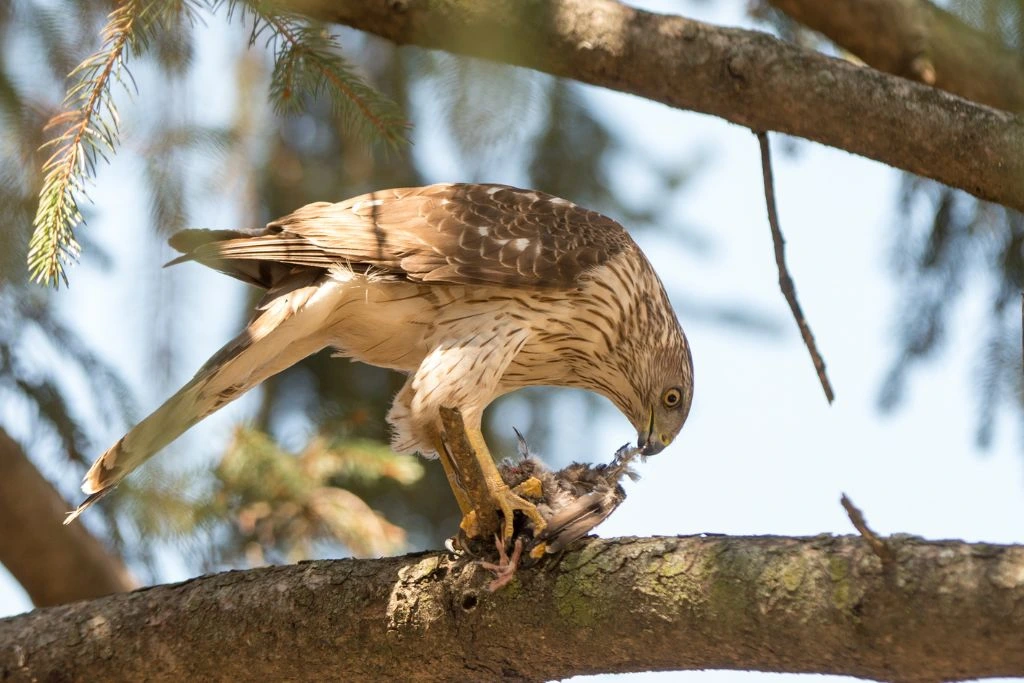
- Kingdom: Animalia
- Phylum: Chordata
- Class: Aves
- Order: Accipitriformes
- Genus: Accipiter
- Species: A. cooperii
Cooper’s hawk (Accipiter cooperii) is native to Michigan and part of the diverse hawk species in the state. They are agile hunters with medium-sized bodies and sharp, hooked beaks. Their long, rounded wings and small bodies allow them to cross dense woodlands and trees during a chase quickly.
These hawks have beautiful plumage, with adults featuring a slate-gray back, dark cap, and distinctive reddish barring on their chests. Juveniles exhibit a brown coloration with vertical streaks. Such variations make identifying Cooper’s hawks an intriguing challenge for birdwatchers.
These animals live on average 10 years in the wild, but some have lived 20. As for their presence in Michigan, these remarkable birds of prey can be spotted throughout the state. Because they like woodland and suburban areas with abundant food, they are seen in parks, wildlife reserves, and even homes.
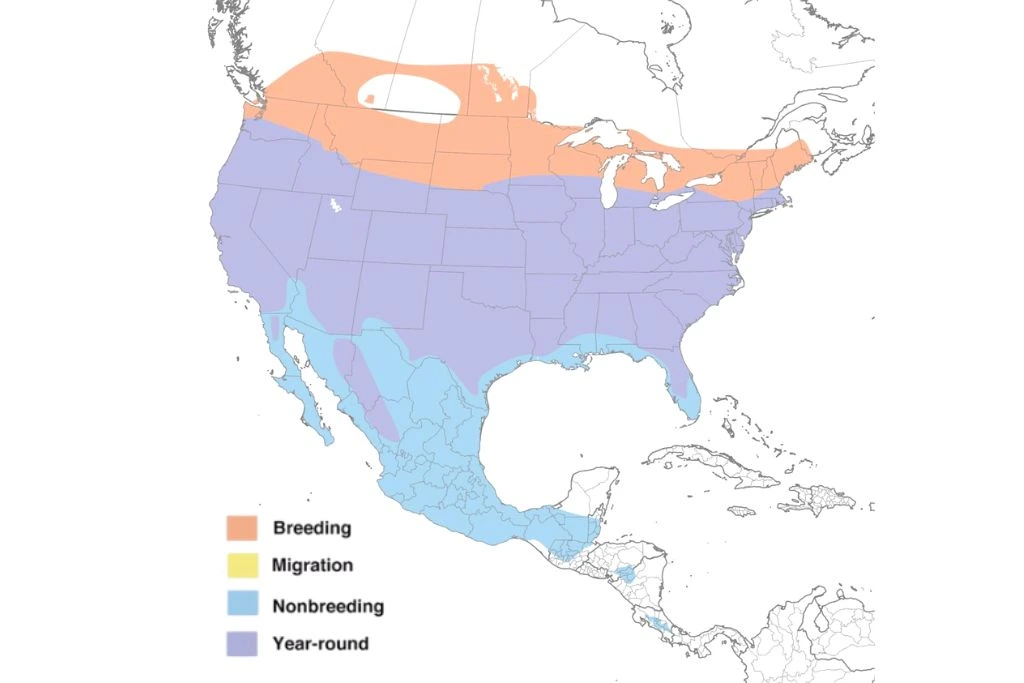
3. Sharp-Shinned Hawk
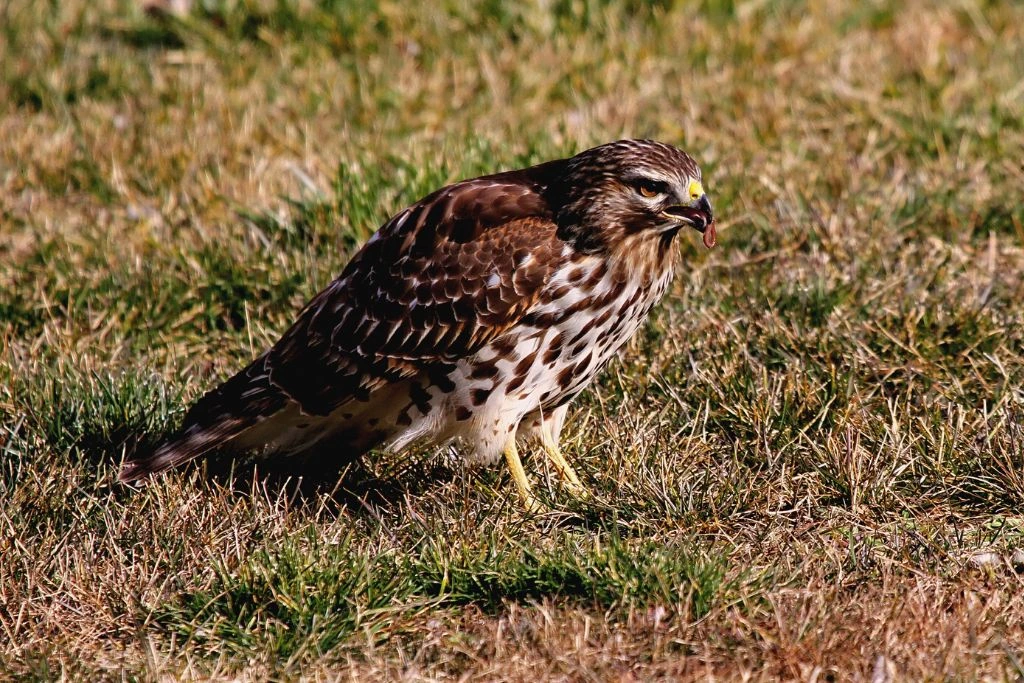
- Kingdom: Animalia
- Phylum: Chordata
- Class: Aves
- Order: Accipitriformes
- Genus: Accipiter
- Species: A. striatus
The sharp-shinned hawk (Accipiter striatus) is a small raptor with a wingspan of 22 to 27 inches and a length of 10 to 14 inches. These hawks showcase sexual dimorphism, with females being larger than males. They possess short, rounded wings and a long, squared-off tail that aids in maneuverability during flight.
The adult birds exhibit a blue-gray coloration on their upper parts and pale underparts with fine, reddish bars. One distinguishing feature is their large, red eyes, surrounded by a distinctive white eyebrow.
Sharp-shinned hawks are monogamous and form breeding pairs during the mating season, which typically begins in early spring. Their nests are constructed using twigs and bark strips and lined with soft materials, such as moss and feathers. These nests are typically located in the canopy of trees, where the young can feel secure and hidden from prying eyes.
They are often confused with the Cooper’s hawk due to their similar appearance. The sharp-shinned hawk has a squared-off tail, whereas Cooper’s hawk has a rounded tail.
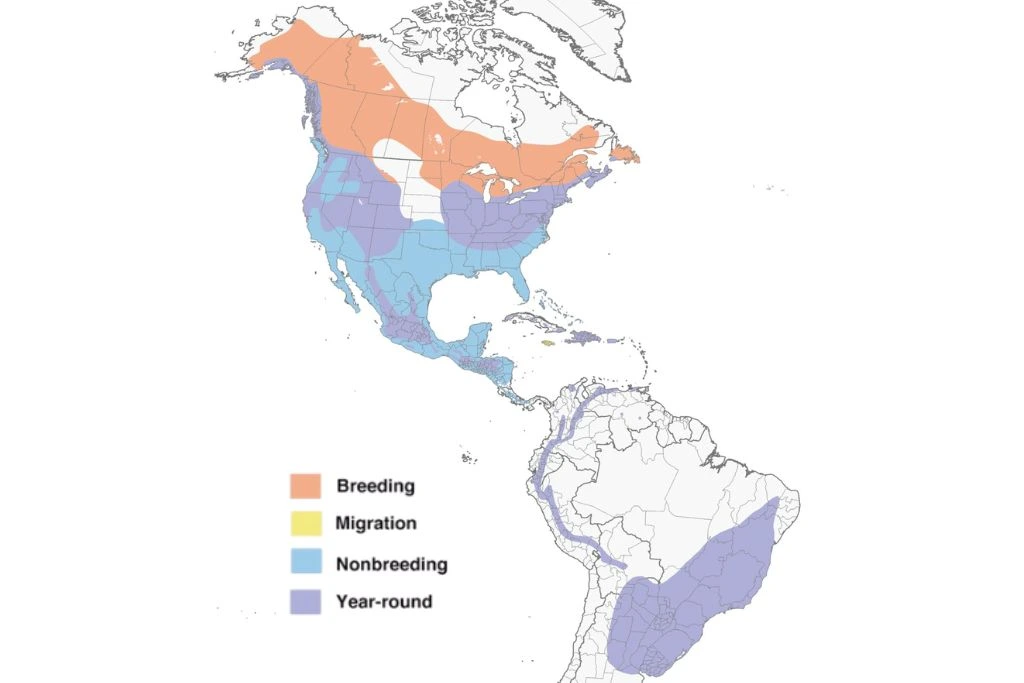
On average, sharp-shinned hawks have a life expectancy of around 5 to 10 years. Predation, diet, and habitat affect their longevity.
4. Rough-Legged Hawk
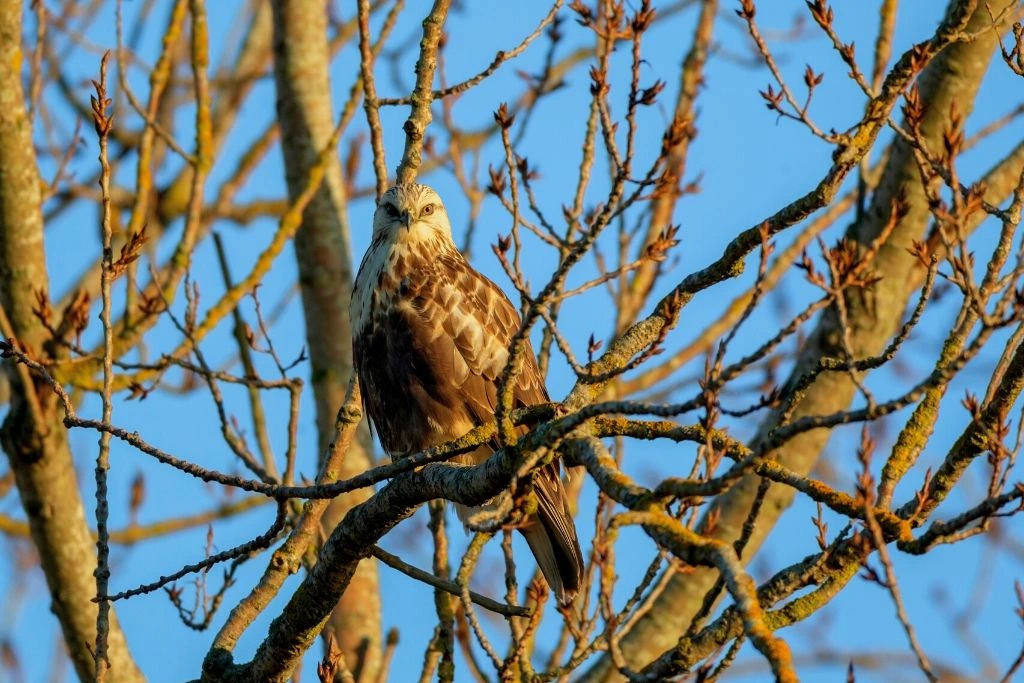
- Kingdom: Animalia
- Phylum: Chordata
- Class: Aves
- Order: Accipitriformes
- Genus: Buteo
- Species: B. lagopus
The rough-legged hawk (Buteo lagopus) has a medium-sized body and a 4-foot wingspan. One of its most notable attributes is its plumage, which includes a mixture of dark and light colors. The adult birds have a distinct white chest, contrasting with a brown or black belly, while juveniles display a mottled pattern.
Its feathered legs protect it from the cold during its northern winter journey. These feathered legs act as insulators, providing added warmth and allowing the hawk to thrive in frigid conditions. Their sharp, hooked beak and sharp eyesight allow them to locate prey from far away.
They have an average life expectancy of around 10 years in the wild, and some have been known to live up to 25 years. Their primary hunting style is hovering mid-air and swooping down to seize prey.
In northern Michigan, rough-legged hawks are often seen in open fields and marshes. If you’re lucky enough to see one, admire its beautiful flight and white chest.
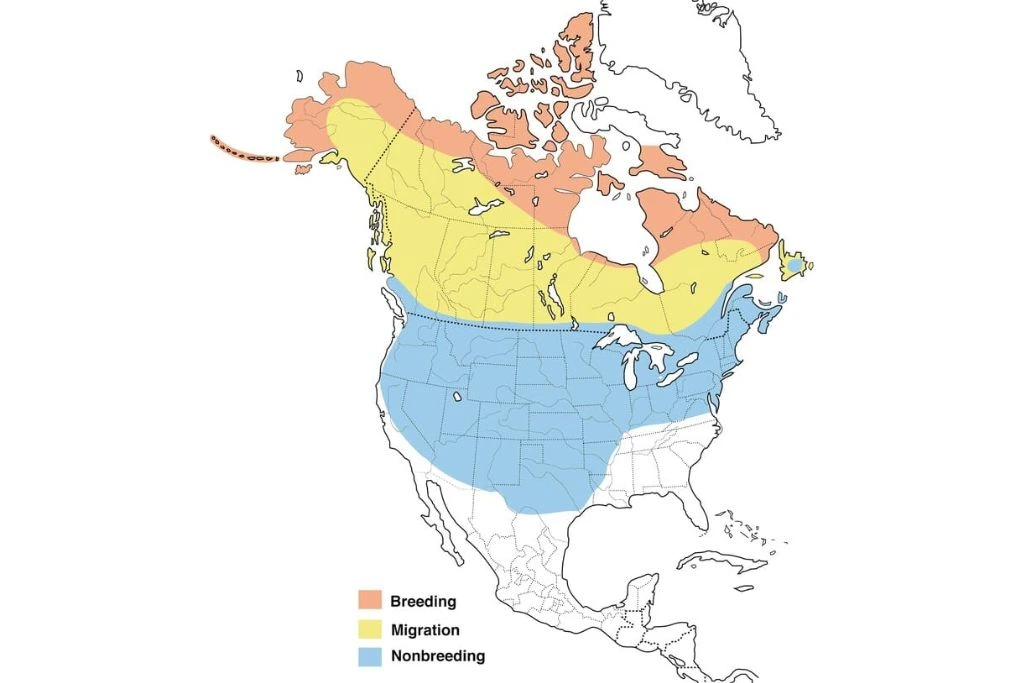
5. Broad-Winged Hawk
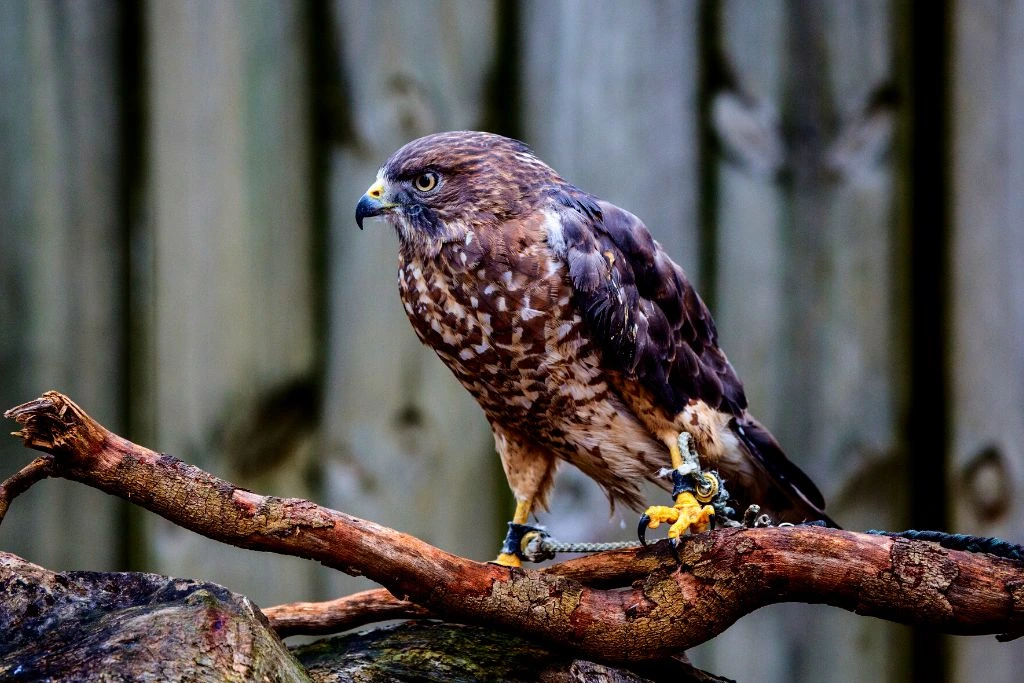
- Kingdom: Animalia
- Phylum: Chordata
- Class: Aves
- Order: Accipitriformes
- Genus: Buteo
- Species: B. platypterus
Broad-winged hawks (Buteo platypterus) are medium-sized, measuring 13 to 17 inches long and 32 to 39 inches wide. They possess broad, rounded wings that aid them in their remarkable flight abilities.
These hawks typically inhabit deciduous and mixed forests, where they can find ample food and suitable nesting sites. They prefer mature forests with a dense understory, providing them with cover for hunting and nesting.
They fly hundreds of miles from North America to Central and South America to breed and in the winter. “Kettling” occurs in fall as big flocks of these hawks spiral upward in thermals before migrating south.
The life expectancy of broad-winged hawks is estimated to be around 10 to 12 years in the wild. These hawks can be spotted throughout Michigan during the summer months when they are breeding and nesting. Look for them in the state’s woodlands, especially in mature forests and dense understory areas.
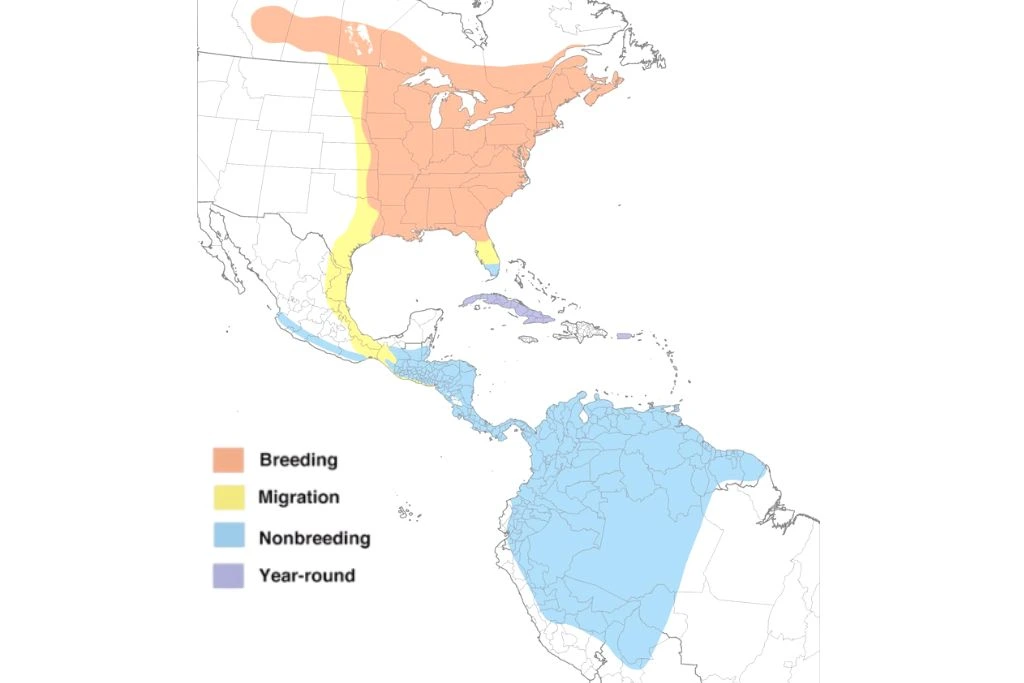
6. Red-Shouldered Hawk

- Kingdom: Animalia
- Phylum: Chordata
- Class: Aves
- Order: Accipitriformes
- Genus: Buteo
- Species: B. lineatus
Characterized by their vibrant plumage, red-shouldered hawks (Buteo lineatus) are easily identifiable. They have a reddish-brown back and wings and a strikingly white chest with vertical reddish bars. As their name implies, their red shoulder patch is their most prominent characteristic, especially as they fly.
Red-shouldered hawks thrive in marshes, swamps, and woodlands near water. Their broad, mighty wings and excellent vision make them a good fit for this environment. These hawks have excellent hunting skills and typically consume rodents, amphibians, reptiles, and other birds.
They can live up to 10 years in the wild, but some can survive for more than 20 years in captivity. Native to Michigan, you can spot these hawks anywhere from forests to wetlands. If you’re lucky, you might see these beautiful birds of prey flying smoothly or perching magnificently on tree branches.
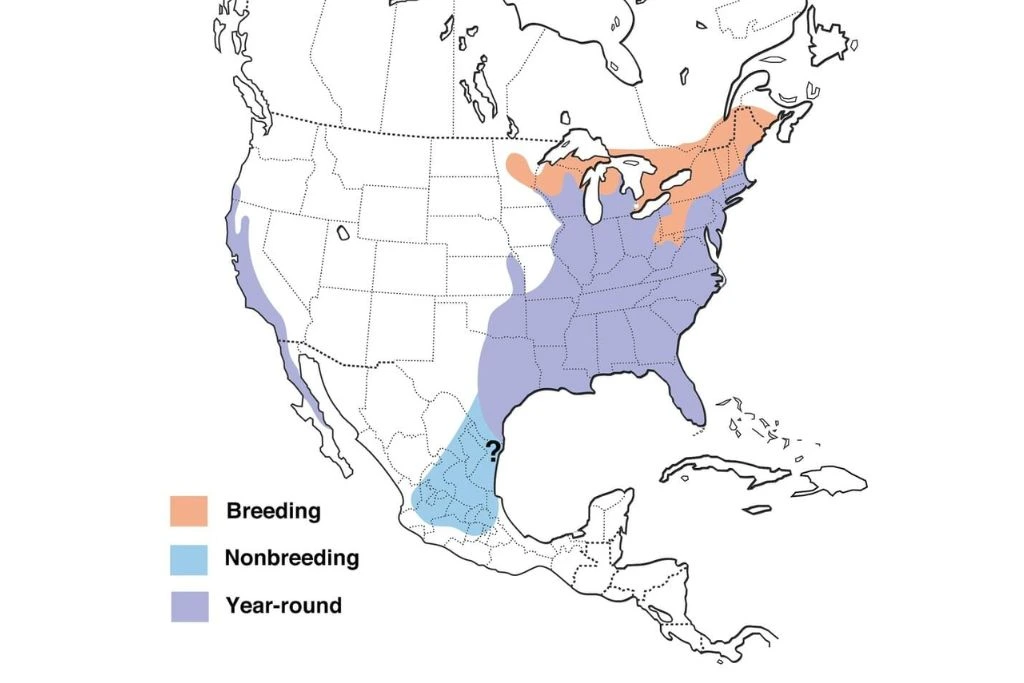
7. Northern Goshawk
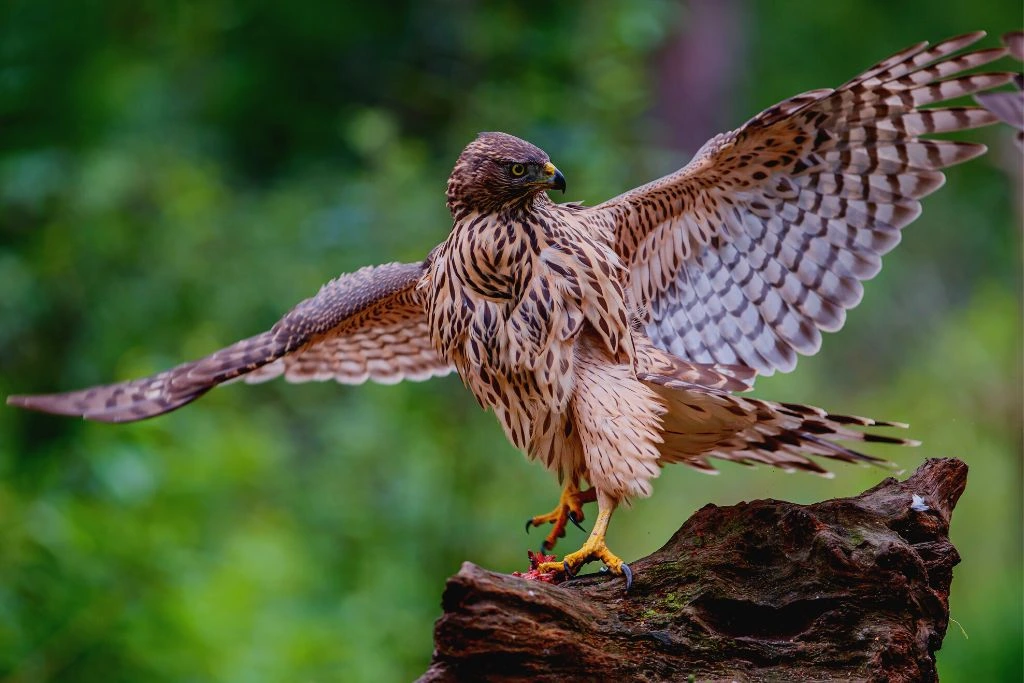
- Kingdom: Animalia
- Phylum: Chordata
- Class: Aves
- Order: Accipitriformes
- Genus: Accipiter
- Species: A. gentilis
Northern goshawks (Accipiter gentilis) are medium-sized hawks native to Michigan. They have broad, rounded tails and short, wide wings, which enable them to maneuver swiftly through dense forests. These hawks have dark gray to black upper bodies and white undersides with subtle gray barring.
They are highly territorial and will defend their nesting areas vigorously. During courting, they undertake acrobatic flight maneuvers and call loudly.
The average lifespan of a Northern Goshawk is 10 to 15 years, but rare individuals have been recorded living as long as 25 years.
In Michigan, northern goshawks are found in the Upper Peninsula and select forested areas. They nest in mature forests with a mix of coniferous and deciduous trees and find plenty of prey there.
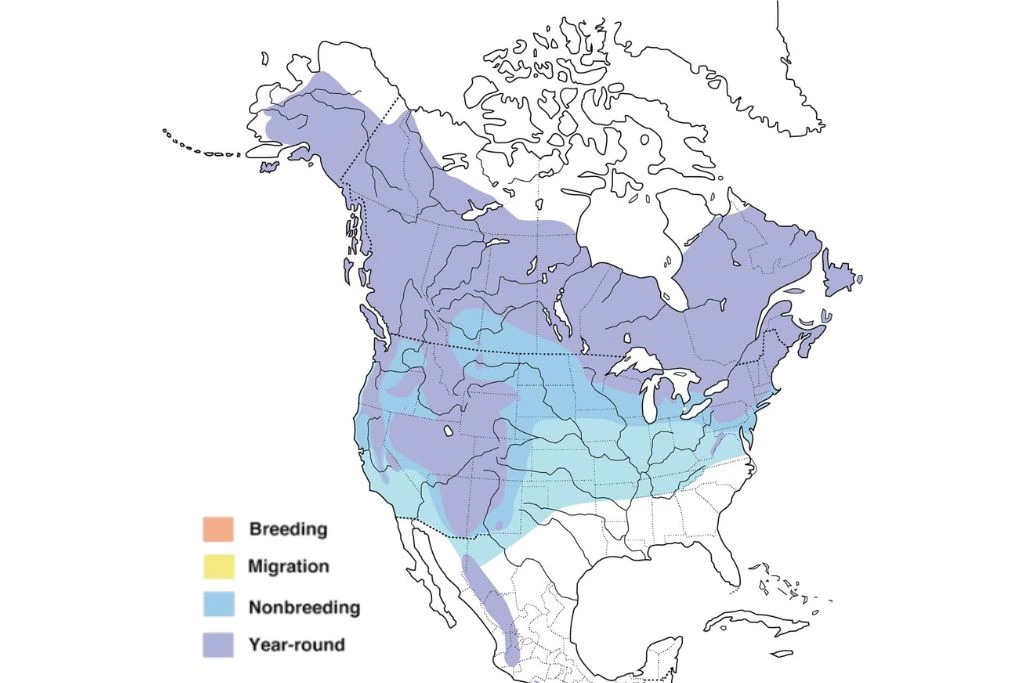
8. Northern Harrier
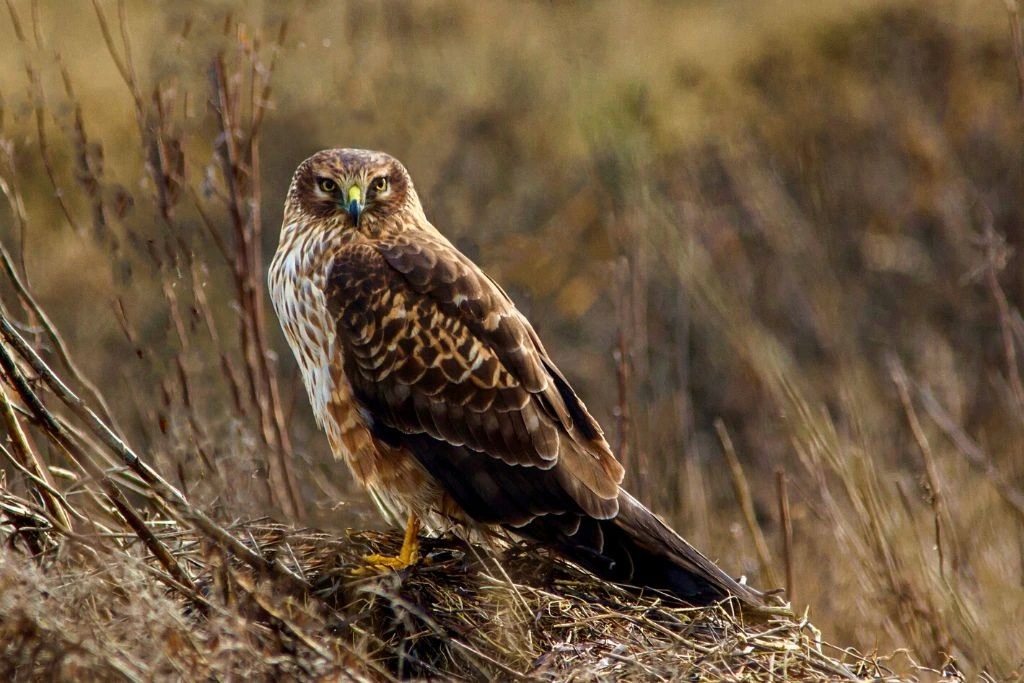
- Kingdom: Animalia
- Phylum: Chordata
- Class: Aves
- Order: Accipitriformes
- Genus: Circus
- Species: C. hudsonius
Northern harriers (Circus hudsonius), with their long wings and slim bodies, are sexually dimorphic. Males have pale gray plumage with black wingtips, while females flaunt a distinctive streaked brown coloration.
They use “owl flight” to navigate easily to find tiny mammals, birds, and rodents in the grasslands. Another remarkable adaptation is their facial disk, which aids in capturing sound waves, helping them precisely locate prey. These characteristics in Michigan’s marshes, meadows, and open fields make them excellent hunters.
The male performs acrobatic moves to impress the female during courtship. These hawks live 5 to 7 years in the wild. Their hunting strategy and preference for small animals and birds regulate rodent populations, making them ecologically important.
They are commonly seen in open grasslands, marshes, and meadows all around the state of Michigan. Michigan nature lovers and photographers can enjoy these little hawks’ grace and beauty in these areas.
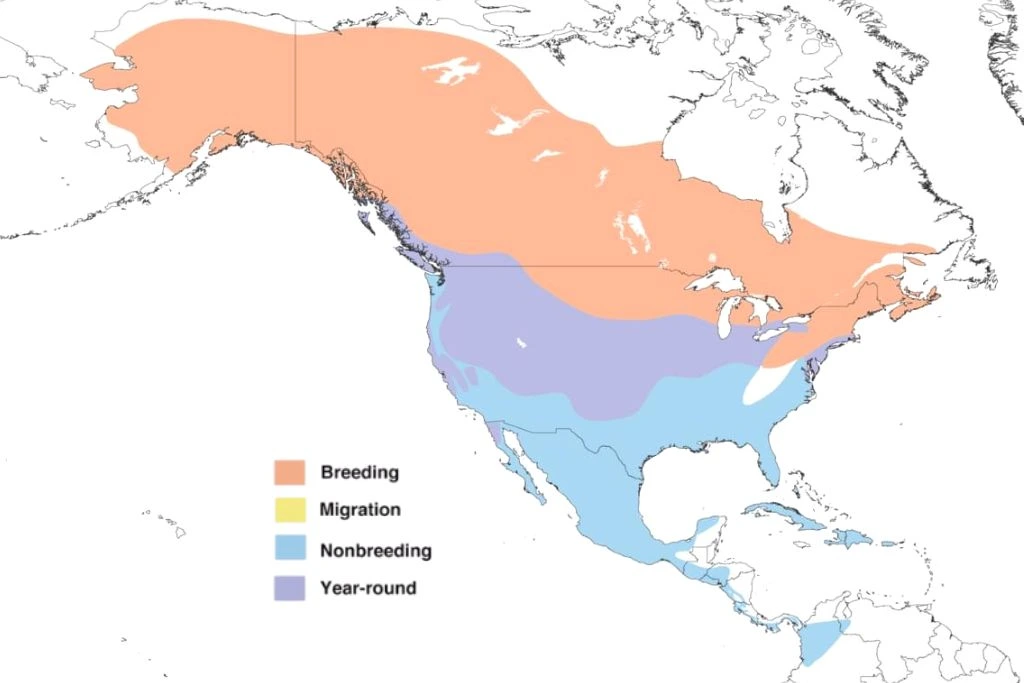
9. Swainson’s Hawk
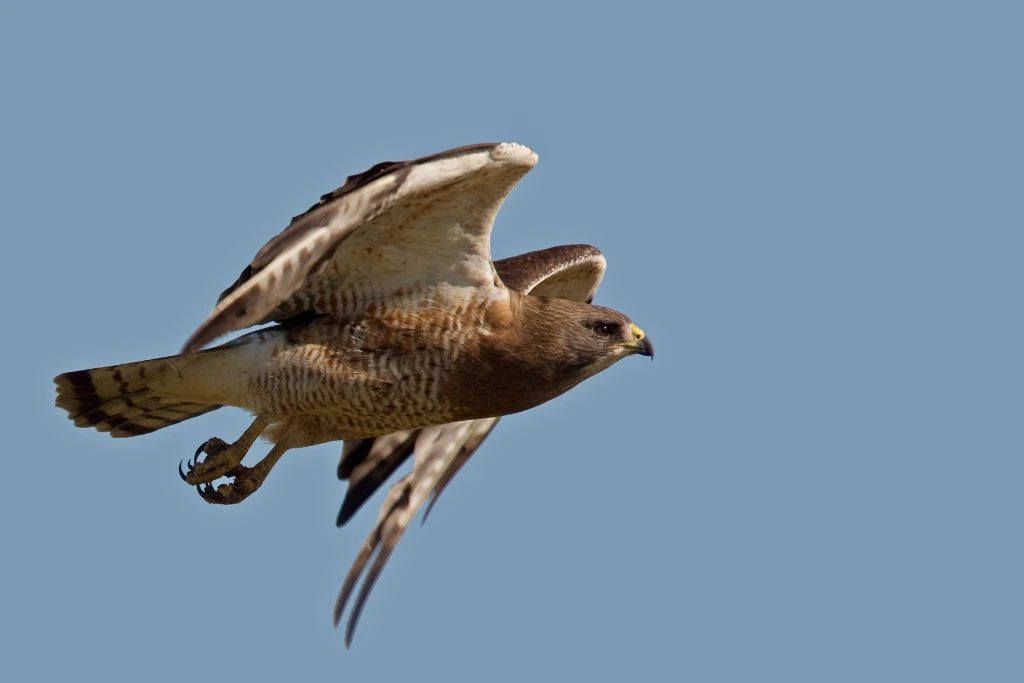
- Kingdom: Animalia
- Phylum: Chordata
- Class: Aves
- Order: Accipitriformes
- Genus: Buteo
- Species: B. swainsoni
Swainson’s hawks (Buteo swainsoni) are characterized by their medium size, slender bodies, and long, tapering wings. Adults typically measure between 18 and 22 inches long and have a wingspan of around 4.5 feet.
This hawk, with white chest and comparatively light underbelly, stands out against the dark brown of their back and wings. This white patch is especially noticeable during their migration periods. Despite being adaptable to many habitats, they favor vast grasslands, agricultural fields, and savannas.
These amazing birds migrate thousands of miles from North America to South America to breed and for the winter. They are among the longest-migrating raptors in the world! They are known for their communal roosting during migration, where hundreds or thousands of individuals gather.
The life expectancy of Swainson’s hawks varies, with an average lifespan of around 10 to 12 years. These hawks can be spotted throughout Michigan during their migration periods, particularly in the spring and fall.
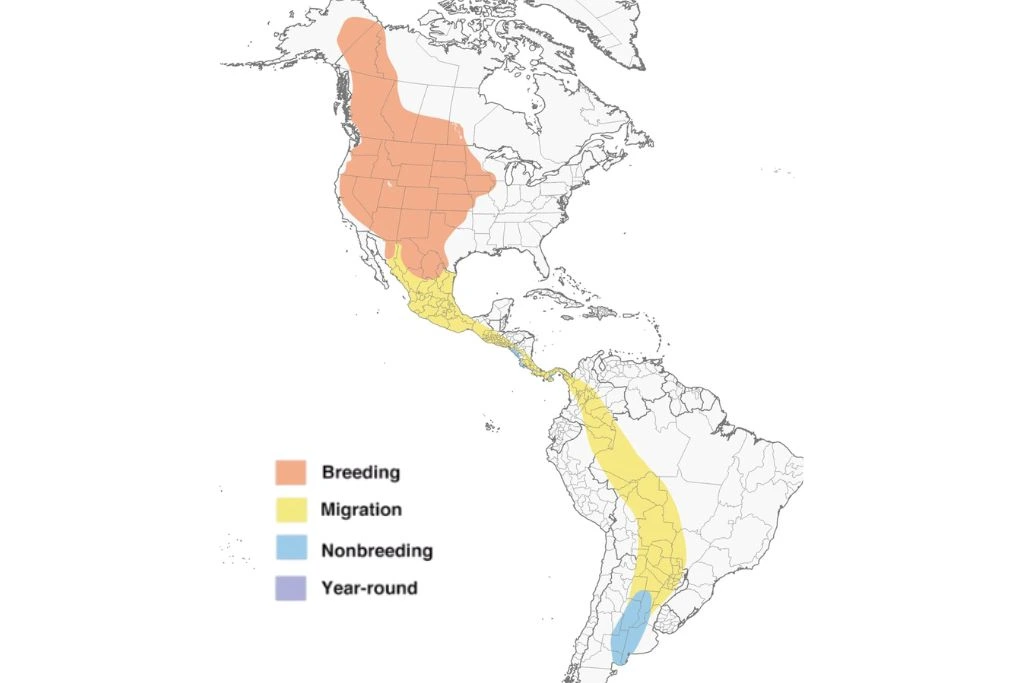
10. Ferruginous Hawk
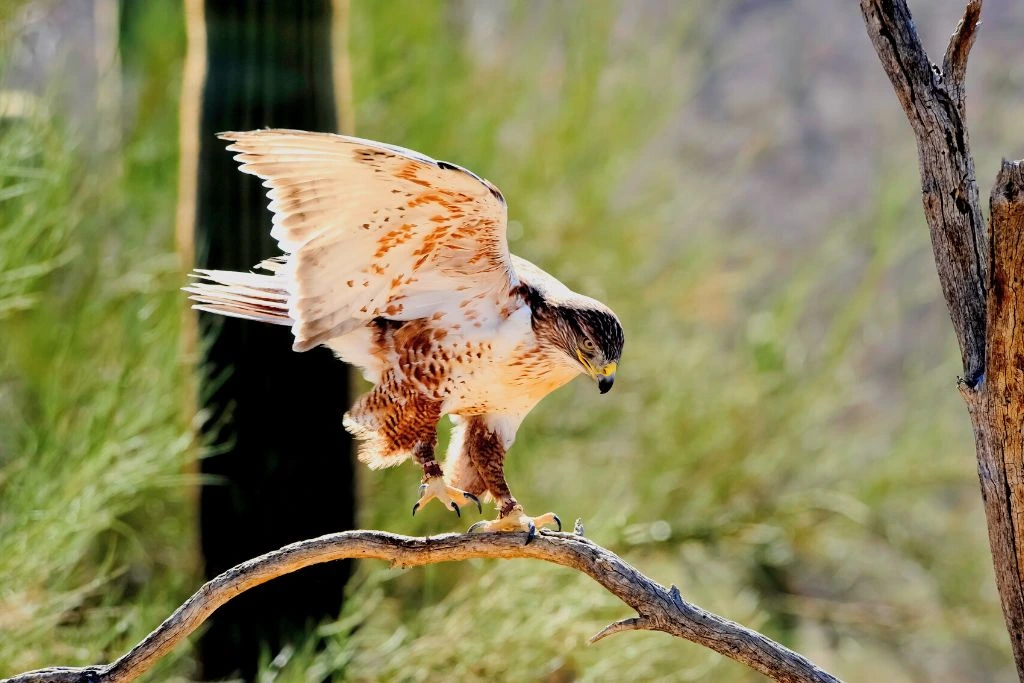
- Kingdom: Animalia
- Phylum: Chordata
- Class: Aves
- Order: Accipitriformes
- Genus: Buteo
- Species: B. regalis
The ferruginous hawk (Buteo regalis), one of the largest buteos in North America, is distinguished by its massive size and sturdy structure. Adults typically measure between 20 to 26 inches long, with a wingspan reaching up to 4.5 feet.
Adults can be identified by their stunning plumage, which consists primarily of a light, reddish hue on the upper parts and a white chest. This contrasting combination of colors makes them easily recognizable among other hawks native to Michigan.
Adapted to thrive in various environments, ferruginous hawks are commonly found in open grasslands, prairies, and shrublands. Their preferred habitats consist of expansive areas with minimal tree cover, allowing them to hunt efficiently. With their keen eyesight and excellent hearing, these hawks are skilled predators.
With an average lifespan of about 10 to 15 years, these hawks can occasionally live up to 20 years in the wild. Open grasslands and agricultural fields in Southern Michigan are ideal hunting grounds for them. Their white chest and striking plumage make them great subjects for Michigan hawk photographers and birdwatchers.
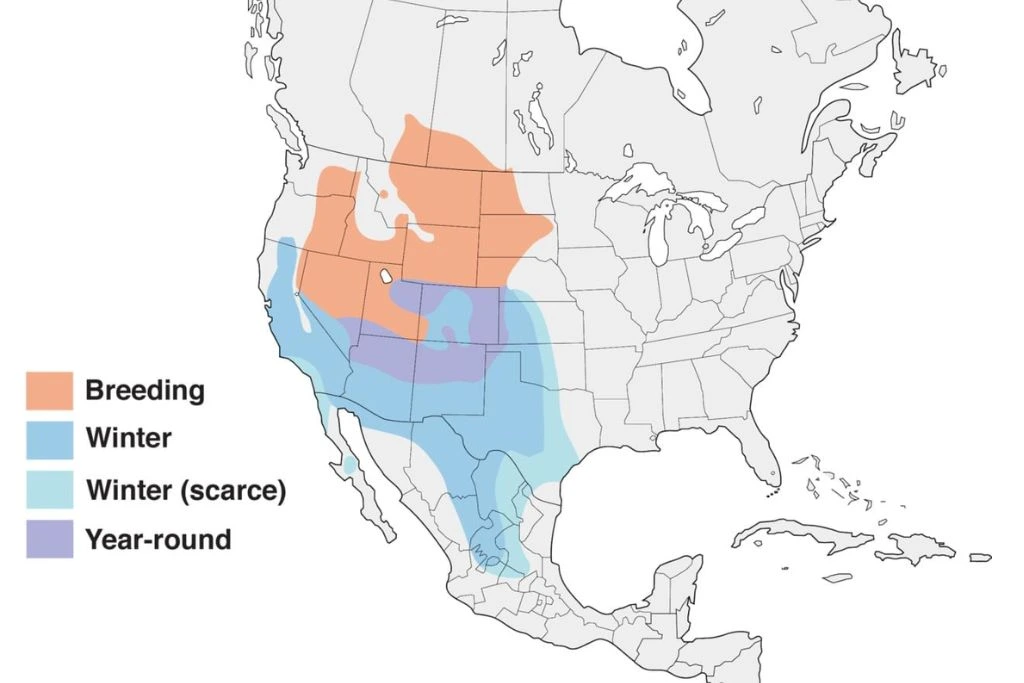
11. Short-Tailed Hawk
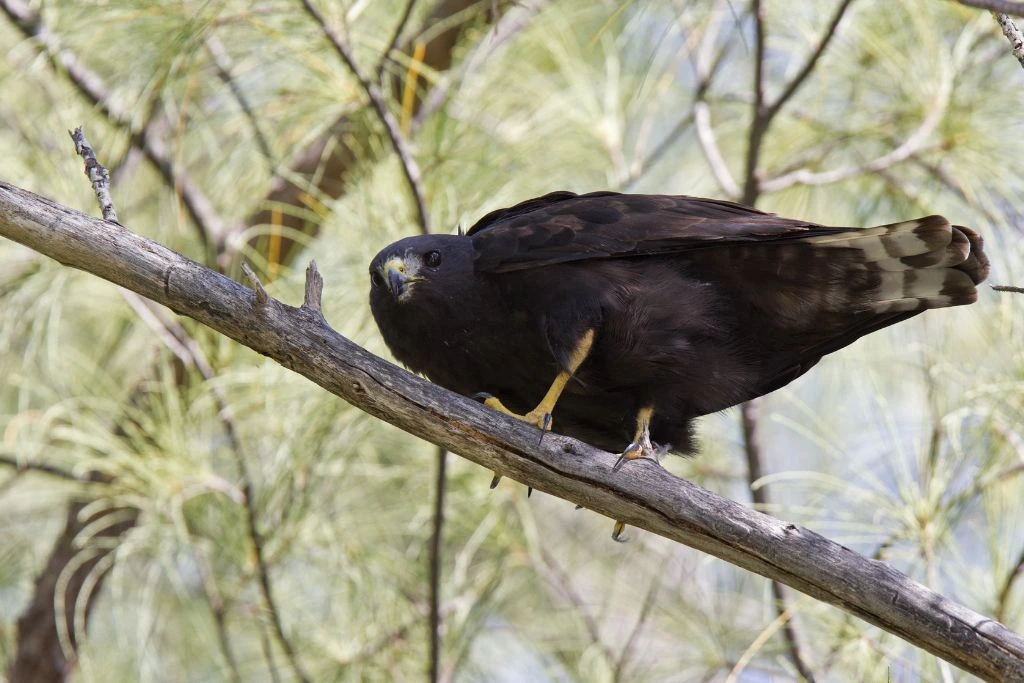
- Kingdom: Animalia
- Phylum: Chordata
- Class: Aves
- Order: Accipitriformes
- Genus: Buteo
- Species: B. brachyurus
The short-tailed hawk (Buteo brachyurus) is one of Michigan’s smallest hawks, measuring 16 to 20 inches. It’s dark brown wings and pale underside with a white chest set it apart from other hawks.
This magnificent bird is known for its excellent vision, allowing it to spot its prey precisely from great distances. It is common to find the short-tailed hawk in Michigan’s woods, marshes, and open fields.
This species demonstrates remarkable versatility in its hunting strategies. While it primarily feeds on small mammals like rodents, it also preys on reptiles, amphibians, and even large insects.
These beautiful birds, which may live for up to 15 years, grace the sky over Michigan with their presence. They are often seen in Southern Michigan but can be found elsewhere. Bird enthusiasts can catch stunning images of hawks in Michigan, notably the short-tailed hawk’s enticing white chest.
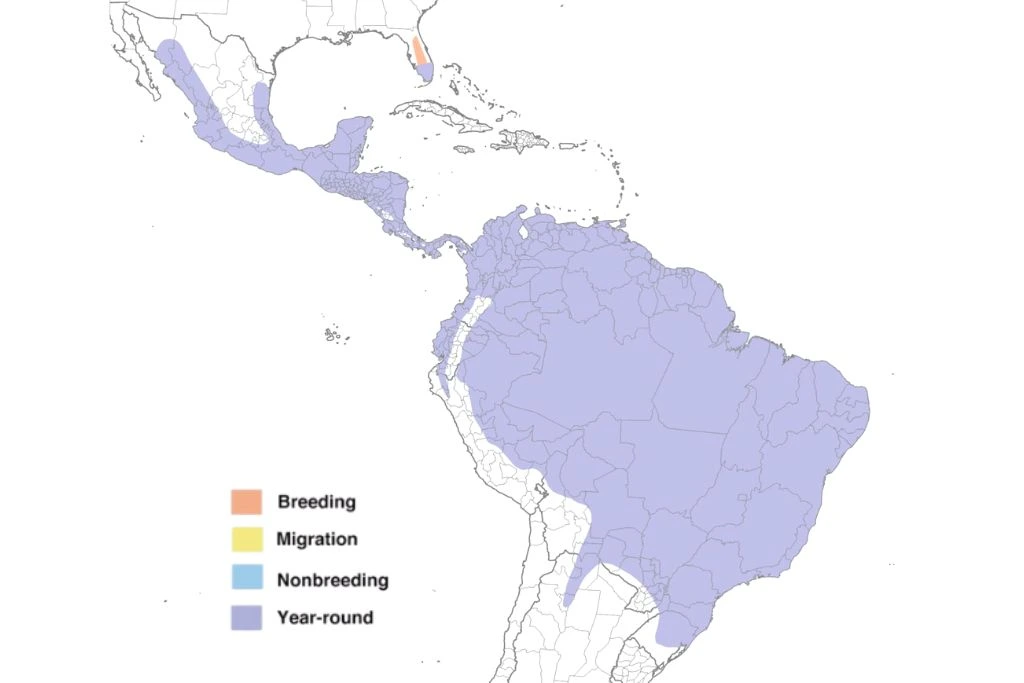
12. Osprey
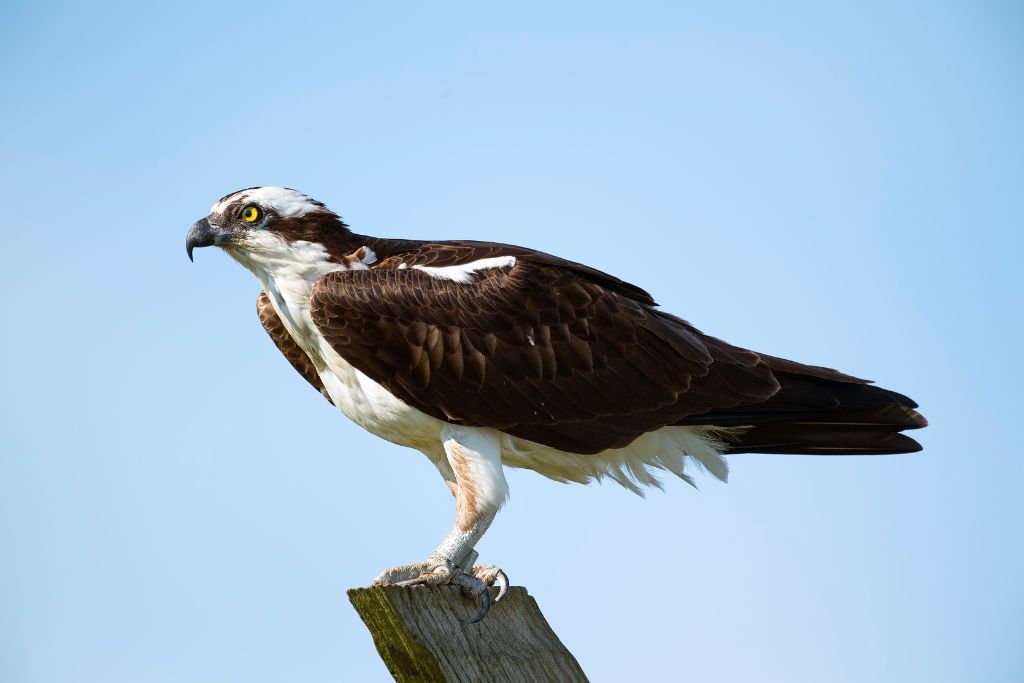
- Kingdom: Animalia
- Phylum: Chordata
- Class: Aves
- Order: Accipitriformes
- Genus: Pandion
- Species: P. haliaetus
Ospreys (Pandion haliaetus) have a 6-foot wingspan and a remarkable combination of dark brown upper body feathers and pristine white underparts. They are easily recognizable due to their curved, sharp talons that it employs to capture and transport prey while in flight. Their unique reversible outer toes and spiky foot pads provide a firm grip on slippery fish, making them exceptional fishermen.
They swarm around bodies of water so they may feast on fish, their primary source of nutrition. These birds have evolved adaptations that aid them in their hunting endeavors. They can smoothly plunge into the water to hunt prey due to their slick feathers and closed nostrils.
They are skilled migratory birds, traveling impressive distances between their breeding and wintering grounds. Ospreys can live up to 20 years in the wild, with some individuals reaching even older. These stunning birds are frequently spotted on the Great Lakes, particularly in Michigan, Superior, and Huron.
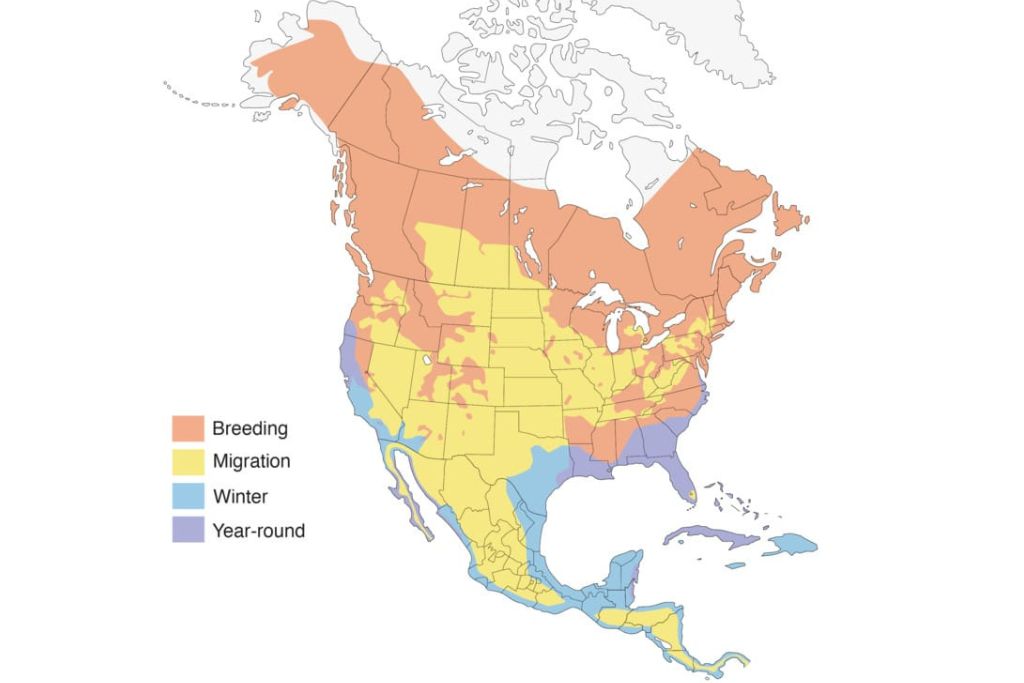
FAQs
Are Hawks Common in Michigan?
Yes, hawks are common in Michigan.
What are the Rarest Hawks in Michigan?
The ferruginous hawk and the Swainson’s hawk are the rarest hawks in Michigan.
What is the Deadliest Hawk in the World?
The harpy eagle is often considered one of the most powerful and formidable hawks.
What is the Smallest hawk?
The sharp-shinned hawk is the smallest hawk, known for its compact size and agility.

